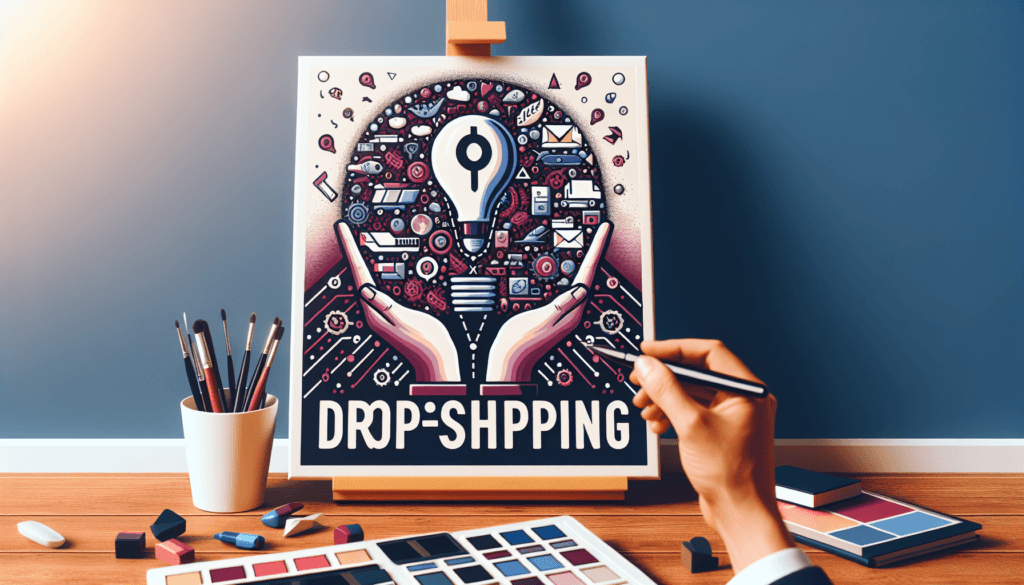Are you ready to embark on a journey to make money online? Look no further than dropshipping! If you’re a beginner in the world of e-commerce and want to start your own business without worrying about inventory and shipping, dropshipping is the perfect option for you. This article will guide you through the essential steps of getting started with dropshipping, from choosing the right products and suppliers to setting up your online store and marketing your products effectively. With determination and the right strategies, you’ll be well on your way to earning a lucrative income from the comfort of your own home.

Choosing a Niche
Identify your Interests and Passions
When starting a dropshipping business, it is crucial to choose a niche that aligns with your interests and passions. By selecting a niche that you are passionate about, you will be more motivated and dedicated to growing your business. Take some time to brainstorm and identify niches that you are knowledgeable about or have a strong interest in. This will not only make it easier for you to select products, but it will also allow you to connect with your target audience on a personal level.
Research Market Demand
Once you have identified your interests and passions, it is important to determine the market demand for the products in your chosen niche. Conduct thorough market research to assess the popularity and profitability of the products you plan to sell. Look for trends, analyze search volume, and identify any gaps in the market. Understanding the demand for your chosen niche will help you make informed decisions when selecting products to dropship.
Analyze Competition
Another vital aspect of choosing a niche is analyzing the competition in that market. Research and evaluate the existing dropshipping businesses that are already operating in the same niche. Look at their product offerings, pricing strategies, and marketing techniques. This will help you identify opportunities to differentiate your business and stand out from the competition. By understanding your competition, you can also learn from their successes and failures, which will be invaluable as you start and grow your own dropshipping business.
Finding Reliable Suppliers
Research Dropshipping Suppliers
Finding reliable suppliers is crucial for the success of your dropshipping business. Research and identify reputable dropshipping suppliers that align with your chosen niche. Look for suppliers that have a wide variety of products, timely shipping, and excellent customer service. You can utilize online directories, such as Alibaba or Oberlo, to find potential suppliers. Read reviews and testimonials from other dropshippers to get an insight into their experiences with different suppliers.
Evaluate Supplier Reliability
Once you have identified potential suppliers, it is important to evaluate their reliability. Communicate with the suppliers to gauge their responsiveness and willingness to work with dropshippers. Ask for samples of their products to assess the quality. It is also crucial to review their return policy and warranty information. By thoroughly evaluating the reliability of your suppliers, you can ensure that you are working with trustworthy partners who will deliver high-quality products to your customers.
Consider Supplier Location and Shipping Times
When choosing suppliers, it is essential to consider their location and shipping times. Opt for suppliers who are located close to your target market to minimize shipping times and costs. Faster shipping times can significantly enhance the customer experience and increase satisfaction. Additionally, consider whether the supplier offers shipping tracking and expedited shipping options. By choosing suppliers with efficient shipping processes, you can provide your customers with a seamless and timely delivery experience.

Setting Up Your Online Store
Choose an E-commerce Platform
Selecting the right e-commerce platform is crucial for building a successful online store. Research and compare different platforms to find one that suits your needs. Consider factors such as ease of use, customization options, affordability, and integration with dropshipping apps. Popular e-commerce platforms like Shopify and WooCommerce offer user-friendly interfaces and a wide range of features specifically designed for dropshipping businesses.
Designing Your Store
Once you have chosen your e-commerce platform, it is time to design your online store. Create a visually appealing and user-friendly website that aligns with your brand image. Choose a clean and professional theme that showcases your products effectively. Ensure that your website is easy to navigate, with clear categories and product descriptions. Use high-quality images and engaging content to attract customers and encourage them to make a purchase.
Optimize Your Product Pages
To maximize conversions and sales, it is important to optimize your product pages. Write compelling product descriptions that highlight the unique features and benefits of each item. Use high-resolution images that clearly display the product from different angles. Incorporate keywords relevant to your niche to improve your search engine rankings. Additionally, include customer reviews and ratings to build trust and credibility with potential buyers. By optimizing your product pages, you can enhance the overall shopping experience for your customers and increase your chances of making a sale.
Managing Inventory and Fulfillment
Automate Inventory Management
Efficient inventory management is essential for the smooth operation of your dropshipping business. Consider using automation tools and software to streamline your inventory management processes. These tools can automatically update your product inventory levels, track sales, and generate purchase orders when stock runs low. By automating inventory management, you can minimize the risk of overselling or running out of stock, ensuring that you can fulfill customer orders in a timely manner.
Selecting Order Fulfillment Methods
When it comes to order fulfillment, you have two primary options: self-fulfillment or outsourcing to a fulfillment center. Self-fulfillment involves managing and shipping the orders yourself, while outsourcing to a fulfillment center allows a third-party to handle the storage, packaging, and shipping of your products. Consider your inventory size, budget, and personal preferences when deciding which method best suits your dropshipping business.
Monitoring and Handling Returns
Dealing with returns is an inevitable part of running a dropshipping business. It is important to establish a clear and customer-friendly return policy. Communicate this policy clearly to your customers to manage their expectations. Implement a system to track and process returns efficiently. Provide timely and responsive customer support to address any issues or concerns related to returns. By effectively managing returns, you can maintain customer satisfaction and build a positive reputation for your dropshipping business.

Driving Traffic to Your Store
Implement SEO Strategies
Implementing SEO (Search Engine Optimization) strategies is crucial for driving organic traffic to your online store. Identify relevant keywords and incorporate them into your website content, meta tags, and product descriptions. Focus on creating high-quality and informative content that is valuable to your target audience. In addition, ensure that your website has a user-friendly structure with intuitive navigation. By implementing SEO strategies, you can improve your website’s visibility in search engine results and increase organic traffic.
Utilize Social Media Marketing
Leverage the power of social media to promote your dropshipping business and drive traffic to your store. Create profiles on popular social media platforms such as Facebook, Instagram, and Twitter. Develop a content strategy that includes engaging posts, product showcases, and customer testimonials. Engage with your followers and respond to their comments and inquiries promptly. Consider implementing paid social media advertising to reach a wider audience and target specific demographics.
Engage in Influencer Partnerships
Collaborating with influencers is a highly effective way to increase brand awareness and attract potential customers. Research and identify influencers in your niche who have a significant following and high engagement rates. Reach out to them and propose a partnership in which they promote your products to their audience. This can be in the form of sponsored posts, product reviews, or giveaways. By leveraging the influence of relevant influencers, you can tap into their loyal fan base and drive targeted traffic to your dropshipping store.
Building Trust and Customer Engagement
Provide Excellent Customer Service
One of the key factors in building trust and fostering customer engagement is providing excellent customer service. Ensure that you respond to customer inquiries and concerns promptly and professionally. Offer multiple channels for customer support, such as email, live chat, and phone. Utilize automated chatbots to provide immediate assistance and address frequently asked questions. By going above and beyond to satisfy your customers, you can build a loyal customer base and generate positive word-of-mouth.
Build a Professional Brand Image
Establishing a professional and trustworthy brand image is essential for gaining customer trust and loyalty. Develop a unique and memorable brand identity that resonates with your target audience. This includes creating a cohesive visual identity with a recognizable logo, color scheme, and typography. Consistently present your brand across all touchpoints, including your website, social media profiles, and packaging materials. By presenting your business in a professional manner, you can instill confidence in your customers and differentiate yourself from competitors.
Create Valuable Content
Creating and sharing valuable content is an effective way to engage with your target audience and build trust. Develop a content strategy that aligns with your niche and provides value to your customers. This can include blog posts, how-to guides, product reviews, and informative videos. Share this content on your website and social media platforms to establish yourself as an authority in your niche. By consistently delivering valuable content, you can position yourself as a trusted source and attract potential customers to your dropshipping business.

Optimizing for Conversions and Profitability
Implement Conversion Rate Optimization Techniques
Conversion rate optimization (CRO) involves optimizing your website and marketing strategies to increase the percentage of visitors who convert into customers. Analyze user behavior on your website and identify areas for improvement. Implement strategies such as personalized recommendations, clear call-to-action buttons, and simplified checkout processes. A/B test different variations of your website to determine which elements yield the highest conversion rates. By continuously optimizing for conversions, you can maximize your sales and profitability.
A/B Testing and Analytics
A/B testing is a powerful tool to analyze and optimize different elements of your dropshipping business. Test different variations of your website, product descriptions, pricing strategies, and marketing campaigns to determine what works best for your target audience. Use analytics tools to track and measure important metrics such as website traffic, bounce rates, and conversion rates. By leveraging data-driven insights, you can make informed decisions to improve the performance and profitability of your dropshipping business.
Cost Management Strategies
Effective cost management is crucial for maximizing profits in your dropshipping business. Optimize your expenses by negotiating favorable terms with suppliers, exploring bulk purchasing options, and utilizing cost-effective shipping methods. Keep track of your expenses and revenue to ensure that your profits outweigh your costs. Additionally, regularly review and optimize your pricing strategy to maximize profitability while remaining competitive in the market. By implementing cost management strategies, you can improve your bottom line and ensure the long-term success of your dropshipping business.
Scaling Your Dropshipping Business
Expand Product Range and Target New Markets
Once your dropshipping business is established and successful, consider expanding your product range and targeting new markets. Conduct market research to identify complementary products that can cater to the needs and interests of your existing customer base. Additionally, explore opportunities to enter new geographical markets by adapting your marketing strategies and tailoring your product offerings. By expanding your product range and target markets, you can increase your revenue streams and open up new avenues for growth.
Outsource Tasks and Automate Processes
As your dropshipping business grows, it may become necessary to outsource certain tasks and automate processes to ensure scalability. Identify tasks that can be effectively handled by third-party professionals, such as customer support or content creation. Explore automation tools and software that can streamline repetitive tasks, such as order processing or inventory management. By outsourcing and automating, you can free up your time to focus on strategic decision-making and business growth.
Invest in Growth and Marketing
To scale your dropshipping business successfully, it is crucial to invest in growth and marketing efforts. Allocate a portion of your revenue for targeted advertising campaigns, influencer partnerships, and other marketing initiatives. Continuously monitor and analyze the results of your marketing efforts to ensure a positive return on investment. Additionally, invest in enhancing your website’s infrastructure, customer support capabilities, and fulfillment processes to accommodate the increased demand. By making strategic investments, you can propel the growth and long-term success of your dropshipping business.

Dealing with Challenges and Risks
Handling Inventory Management Issues
Inventory management can present various challenges, such as fluctuations in demand, stockouts, or excess inventory. Implement forecasting techniques to anticipate demand and plan your inventory accordingly. Establish relationships with backup suppliers to mitigate the risk of stockouts. Regularly review your inventory levels and sales data to identify slow-moving or obsolete products and adjust your purchasing decisions accordingly. By efficiently handling inventory management challenges, you can maintain a well-functioning dropshipping business.
Addressing Supplier Disputes
Despite careful evaluation, disputes with suppliers can sometimes arise in dropshipping businesses. Communication is key in resolving such issues. Contact the supplier directly to communicate your concerns or dissatisfaction. Provide clear and specific information about the issue and suggest potential solutions. Aim to find a mutually beneficial resolution, whether it involves renegotiating terms, replacing defective products, or seeking a new supplier. By effectively addressing supplier disputes, you can maintain a productive relationship and ensure a consistent supply of high-quality products.
Mitigating Customer Complaints
Customer complaints are inevitable in any business, including dropshipping. It is crucial to handle these complaints promptly and professionally. Respond to customer inquiries and concerns in a timely manner, aiming to resolve the issue to the customer’s satisfaction. Implement a system to track and address complaints, ensuring that you learn from each situation to prevent similar issues in the future. By effectively managing customer complaints, you can maintain customer loyalty and prevent negative reviews or word-of-mouth.
Mastering Dropshipping for Long-Term Success
Constantly Learn and Adapt
The dropshipping industry is constantly evolving, and it is important to stay updated with the latest trends, technologies, and strategies. Continuously learn from industry experts, attend webinars or conferences, and engage with dropshipping communities. Monitor your competitors and learn from their successes and failures. By embracing a mindset of continuous learning and adaptation, you can stay ahead of the curve and ensure the long-term success of your dropshipping business.
Focus on Customer Lifetime Value
Rather than solely focusing on acquiring new customers, prioritize the lifetime value of your existing customers. Implement strategies to encourage repeat purchases, such as loyalty programs, personalized recommendations, and exclusive offers. Nurture customer relationships by providing exceptional customer service and regularly engaging with them through email marketing or social media. By focusing on customer lifetime value, you can maximize customer retention and increase the profitability of your dropshipping business.
Innovate and Differentiate
To stand out in the competitive dropshipping market, it is important to innovate and differentiate your business. Constantly look for new product opportunities, unique marketing approaches, or innovative customer experiences. Differentiate your brand by offering added value or exclusive features. Embrace innovation by adopting new technologies, such as virtual or augmented reality, to enhance the shopping experience. By consistently innovating and differentiating yourself, you can attract new customers and retain their loyalty in the long run.
In conclusion, getting started with dropshipping as a beginner requires careful consideration of various aspects. From choosing the right niche to mastering the art of customer engagement, there are numerous steps involved. By following the comprehensive outline provided in this article, you can lay a strong foundation for your dropshipping business and set yourself up for long-term success in the online marketplace. Remember to constantly learn, adapt, and innovate to stay ahead of the competition and meet the evolving needs of your customers.


